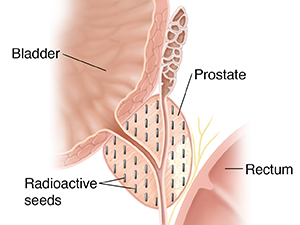Prostate Cancer: Interstitial Brachytherapy
Prostate Cancer: Interstitial Brachytherapy
Radiation therapy is one way to destroy cancer cells. Cancer cells die for months after the therapy ends. Radiation can be given from outside or from inside the body. Radiation given from inside the prostate gland is called internal radiation. It’s also known as interstitial brachytherapy.
How it works
During this therapy, sources of radiation are put inside the prostate. Tiny metal seeds are used. They are about the size of a grain of rice. The seeds can be left in place permanently. Or they may be removed later. The benefit of this kind of treatment is that the radiation is limited to a small area. It does not affect the whole body.
Possible risks and complications
All procedures have risks. Most risks from this procedure are related to organs that are near the prostate and may be affected by the radiation. The risks include:
Bowel problems
Blood in the urine or semen for a short time after treatment
Bleeding or inflammation of the bladder or rectum
Burning feeling when urinating
Erectile dysfunction
Loss of bladder or bowel control (incontinence)
Movement of seeds out of prostate
Needing to urinate often
Pain, bruising, or swelling where the needles were inserted
Urinary obstruction
Before treatment
You may be given hormone therapy to shrink the prostate. An ultrasound, CT scan, or an MRI is then used to map the size and shape of the prostate.
During treatment
You are given anesthesia to keep you free from pain during the procedure. You will have one of these 2 treatments:
Permanent seeds. Permanent seeds are known as low dose rate (LDR) brachytherapy. LDR can be done during an outpatient visit. This means you can go home the same day. The healthcare provider uses a needle to put tiny radioactive seeds into the prostate gland. The needle is guided using images from a transrectal ultrasound.
Temporary seeds. Temporary seeds release a single high dose of radiation (HDR). The healthcare provider puts small tubes (catheters) into the prostate gland. The catheters are hooked up to a machine. The machine sends strong radioactive sources into the prostate for several minutes at a time and then removes them. This is done a few times. The catheters are removed after the last treatment. You may need to stay in the hospital for 1 to 2 days during this treatment. The permanent brachytherapy procedure takes about 1 to 2 hours.
After treatment
Soon after treatment, you can resume your normal activities. Your healthcare team will help you to manage any side effects. With permanent seeds, you may need to restrict your contact with young children and pregnant women for a period of time. You may also need to take other precautions. Talk with your healthcare team.
Updated:
June 05, 2017
Reviewed By:
Alteri, Rick, MD,Gersten, Todd, MD
